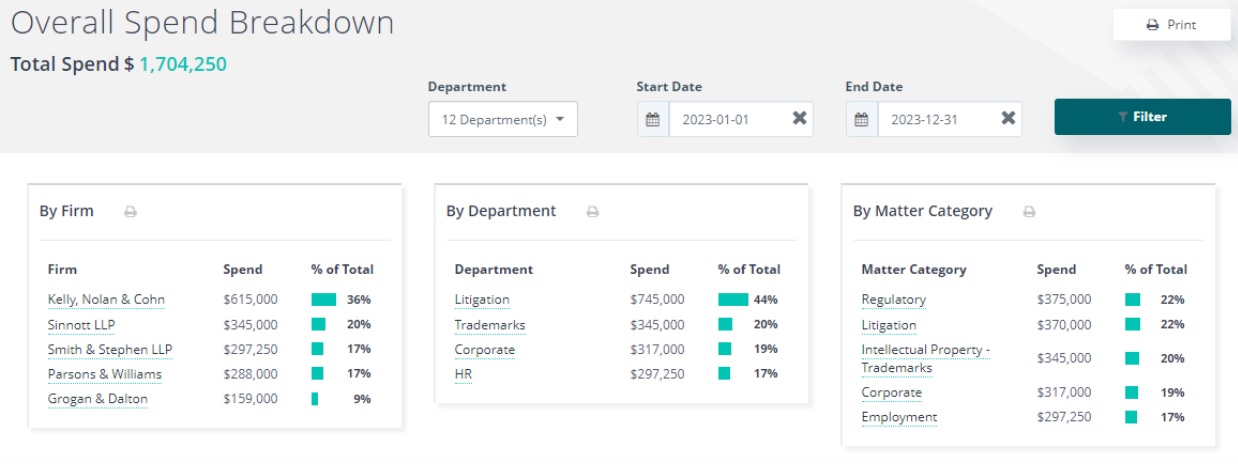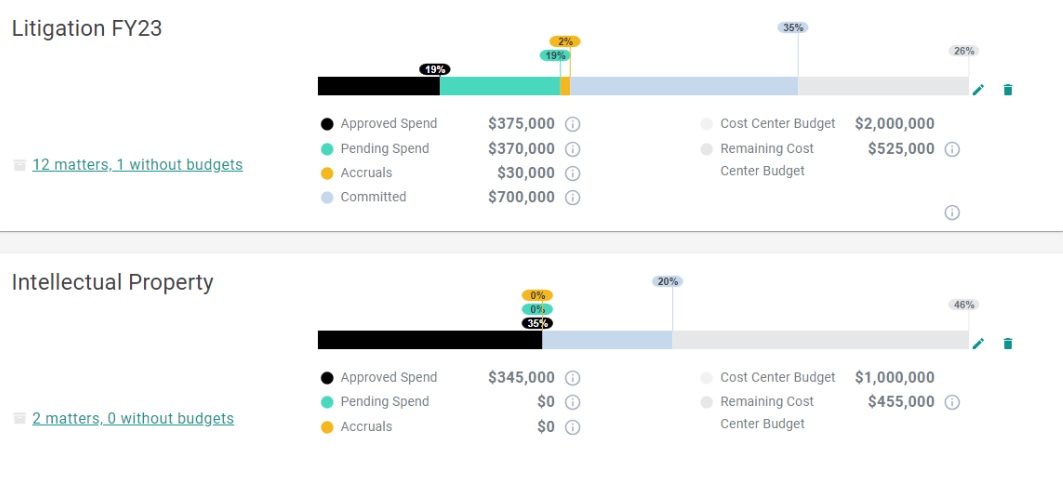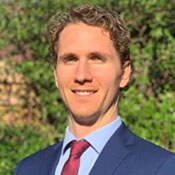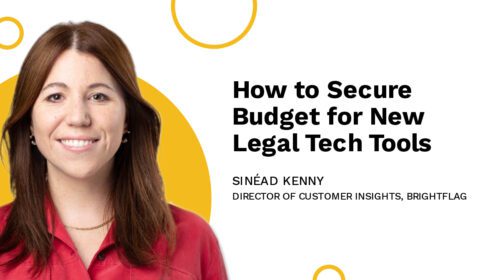Tracking Legal Spend: The Questions All Good Budget Reports Answer
Budgeting isn’t the first thing most people think about when they think of the legal function.
But, if you’re a senior legal leader or a legal operations professional, budgeting inevitably takes up a significant portion of your time and headspace.
The good news is, budgeting doesn’t have to be a struggle. When you know the questions your finance team and CFO will ask about your legal budget, and you have the data on hand to answer them, annual budgeting can be transformed from a stressful exercise to an arena where legal teams flex their business muscle.
That’s because money is the language of business. And for legal to be seen as a creator and protector of business value, they need to be able to confidently control their budget using informed legal spend management strategies.
In this blog, we cover the budget questions you can expect from your finance team, and the reports you can use to answer them.
How Much Has Legal Spent This Year?
This seemingly straightforward question is not so easy to answer if you don’t have the data you need.
If you don’t have a system of record for tracking legal spend, it can be very difficult to get a sense of what you have spent in a given financial period.
Because in the absence of a dedicated legal e-billing system, your accounts payable (AP) team is the only team that keeps track of legal spend.
That means that in order to get an up-to-date report on legal spend, you have to request this information from AP. But AP has its own set of priorities. So legal usually waits days, if not weeks, to get a response to their request for a spend report, by which time the report is out of date. And the cycle repeats.
This can leave you in the very awkward position of being asked how much legal has spent during meetings with your CFO, finance team, and/or with leadership—and having to answer ‘I don’t know’.
If you have an e-billing and legal matter management system in place, answering this question gets so much easier. In Brightflag, legal leadership can access a dashboard that immediately shows them total legal spend for this financial year. You can also slice and dice this data with different metrics to look at other time periods. Or you can zoom in on spend in particular departments, with certain vendors and law firms, or within specified types of legal work, such as litigation or intellectual property.

How is Legal Spend Tracking to Budget?
After finding out what you’ve spent so far this year, you’ll need to compare this to how much was budgeted to see if you’re going to meet or overshoot your budget projections.
Good budget reports provide the metrics to immediately surface your budget for the given financial period and how much you’ve spent so far. They give you a sense of whether you’re on track to come in under budget for the year, or whether spend is pacing higher than you expected.
Armed with these budget reports, legal teams can spot potential budget overruns early, allowing for strategic decision-making to mitigate the risk of overrun.

There are three levels at which you can track spend to budget, ranging from least to most sophisticated.
Tracking Overall Spend to Budget
If you’re new to budgeting, start by tracking spend to budget at the overall level. Every legal team has an overall budget, whether you’re aware of it or not. It’s determined by your finance team and is in the profit and loss (P&L) statement for your company.
Find out the budgeted amount if you don’t know it already, and use your legal e-billing system or reports from AP to track spend against it.
Tracking Spend to Budget by Vendor, Department, or Type of Legal Work
If you’re already tracking your budget at the overall level, you can get more sophisticated by tracking budgets at the department level, vendor/outside counsel law firm level, or by the type of legal work.
It’s best to align with your finance team on the optimal way to set up these sub-budgets for your business.
In the example below, the legal department has decided to track budgets for litigation and intellectual property spend. This way, they can make sure these two high-spending categories of work are under control, which gives them certainty that they will not exceed their overall budget for the year.

Tracking Spend to Budget by Matter
The best legal teams track budgets at the level of individual matters. This can be thought of as a bottom-up approach to budgeting, and is compatible with the top-down approach of tracking budgets at the overall, department, entity, or category of work level.
Setting budgets at the matter level instills a budgeting mindset in all in-house counsel team members and outside counsel law firms working on your legal matters. And by ensuring that all individual matters stay within budget, you gain certainty that you can stay within your overall budget for the year.
It can be difficult to track matter spend to budget—particularly in real-time—without an e-billing system, as most accounts payable systems do not track spend at the matter level.
However, if you do have an e-billing system, it should allow you to report on matter spend to budget.

How Much Budget Does the Legal Department Forecast They Will Need Next Year?
Answering this question with confidence is the holy grail of legal budgeting. If you can forecast with confidence the amount of spend legal will need to support the business in the next financial period, the task of ensuring you stay within budget gets ten times easier.
Many in-house professionals assume that this question is impossible to answer, given the unpredictable nature of legal spend.
However, when you have the right reports in-hand, many types of legal spend are more predictable than they seem. They can typically be broken into three categories:
1. Legal Spend You Can Predict with an Annual Plan
This type is based on the needs and future plans of your business.
For example, legal employment spend is a function of the number of employees the business plans to hire next year, and commercial spend is a function of the number of customers or the volume of revenue your sales team plans to add.
You can use reports on historical data on legal spend and assumptions from the annual plans of other functions to forecast this spend.
2. Other Legal Spend You Can Predict
Some legal costs appear unpredictable because they aren’t part of annual planning. In these instances, you can use a combination of historical data and investigation to get a pretty good estimate of future expenditures.
For example, you can’t predict when your next inbound litigation case will arise, but you can report on the number of lawsuits your company has experienced in the past and how much the associated legal services cost. Correlate that to your organization’s growth, and you can come up with a relatively reliable estimate.
3. Legal Spend You Can’t Predict
Some future events simply can’t be anticipated. For example, the COVID-19 pandemic could not reasonably be predicted, but had a significant impact on corporate legal department expenses for many businesses. It’s better to disregard these in your legal budgeting and reporting. Instead, use the data and reports available to you to plan for what you can reasonably anticipate.
For more detail on the keys to legal spend management, you can read our Predicting Legal Spend ebook.
Leading the Way with Optimized Legal Budget Reports
Legal budgeting might seem like a challenge. But if you have reports that can help you answer questions on how much your legal department has spent, how spend is tracking in relation to the legal department budget, and how much budget legal will need next year, annual legal budgeting doesn’t have to be such a struggle.
In fact, you’ll be showing that your legal department speaks the language of business, and can confidently control their finances through cost-effective legal spend management initiatives.
Interested in learning how Brightflag can help your legal team level up their legal spend tracking and budget planning capabilities? Book a demo today.



